California’s Dogged Drought Cutting Off Water Supplies to State’s Poor
Farmers are guzzling groundwater while wells of families run dry.

By Brett Walton
Circle of Blue
MONSON, California — Just as summer in the San Joaquin Valley was reaching a full boil in June, the Colunga family lost its water and its connection to the modern world.
Like a reliable workhorse suddenly stressed beyond its limit, the family’s 70-year-old water well coughed, gasped, and, in a final dusty breath, died. For more than two months, often in 100-degree heat, Gladys and Jorge Colunga and their six children, ages six months to 16 years, have lived without running water. They are one of at least eight families in this unincorporated Tulare County community of 30-odd homes whose wells have gone dry this year.
The Colunga’s plight, coming in the midst of California’s record-setting drought, exposes a telling gap in state and local water codes – namely a failure to track and regulate groundwater use – that is diminishing the quality of life and putting the health of thousands of poor and vulnerable residents in peril.
The source of the problem is simple to explain. The domestic wells of many of the state’s rural families are no longer deep enough to reach sinking groundwater reserves. California this year is enduring the harshest of three consecutive dry years. The competition for water is fierce.
–Andrew Lockman, manager
Tulare County Office of Emergency Services
Historically low supplies of surface water are available to California’s farms. In response, farmers have launched a well-drilling free-for-all in the Central Valley, the nation’s richest patch of farmland. That is causing the water table to plummet to levels that leave the Colungas and hundreds of other households with empty wells and a surplus of frustration.
“We’re in California, this shouldn’t be happening,” Gladys told Circle of Blue. Gladys was born in a town near Monson, but her husband is from Mexico, a cultural touchstone for many in the area who emigrated north.
“Everyone looks to California and the United States because it’s a better life here,” Gladys said, in disbelief at her family’s misfortune and suggesting that the better life is being spoiled. “It’s hard to believe, but [a dry well] happened to us.”
It’s happening not just in Monson. Tulare County, which is nearly the size of Connecticut and among the 100 largest counties In the U.S., has emerged as the epicenter of a water crisis that is growing worse with each dry month. Well failures are afflicting both public water systems, which serve hundreds or thousands of people, and private domestic wells that anchor a family.
In Seville, a town criticized by a United Nations lawyer in 2011 for a faltering water system, some 600 residents have had intermittent water access this summer due to a deteriorating well and leaking pipes.
In East Porterville, nearly a thousand people with unreliable wells received emergency supplies of bottled water last week, while the fire department maintains a community filling station for non-potable water.
Yet a precise count of people without running water is not known, said Andrew Lockman, manager of Tulare County’s Office of Emergency Services. “We’ve never had to track this before,” Lockman told Circle of Blue. “It’s never been an issue like today.”
Lockman has a list of 120 homes that have reported a dry well to the county, but he acknowledges that the tally is far from comprehensive. That lack of knowledge is emblematic of a state that was largely caught off guard by the depth of the drought and the consequences of the run on groundwater. Safety nets at all jurisdictions – local, state, and federal – were not ready to be deployed, if they existed at all.
Little Precipitation and No Water Limits
The origins of the groundwater crisis are found in the granite basins of the Sierra Nevada mountain range and in the marble corridors of the state Capitol.
The serrated Sierra Nevada range on the California-Nevada border pokes holes in the winter sky, draining it of moisture held in the uplifted Pacific air. As the snow melts, it fills rivers and reservoirs and replenishes groundwater reserves, the main water sources for 38 million Californians.
But the winter of 2013-14 was a colossal hydrological dud. The snowpack, following two subpar seasons, was third lowest on the books. State and federal water managers whittled allocations from the reservoirs and canals to a bare minimum. Some cities and farms, which typically use 80 percent of California’s water, received no water at all.
“The severity caught me by surprise,” said Mark Cowin, director of the California Department of Water Resources, when testifying in February before the California Water Commission, an advisory body.
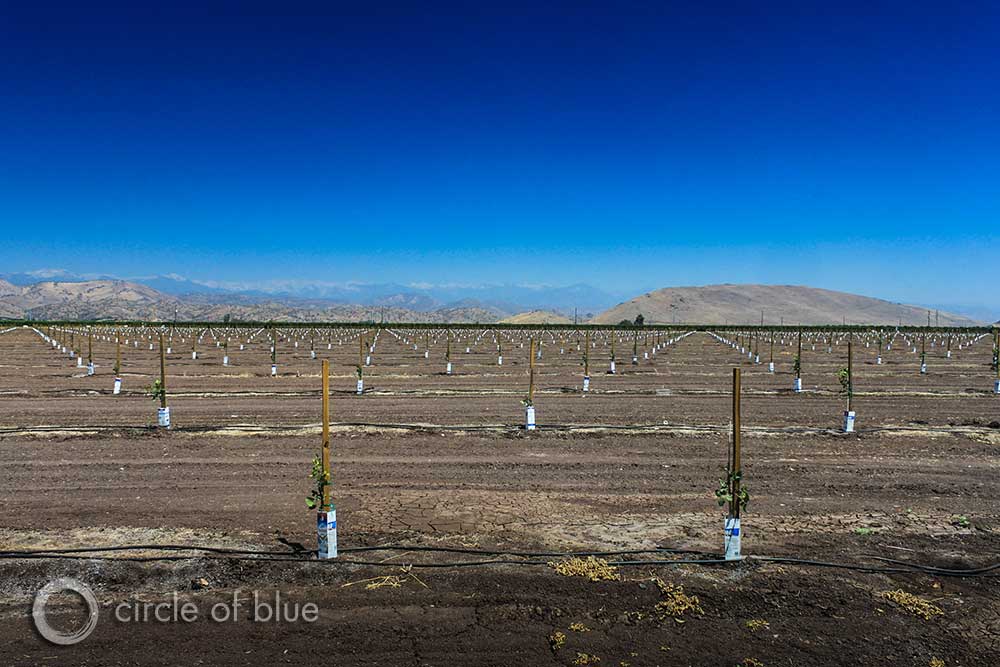
Thinking rationally, farmers acted to save valuable fruit and nut trees, expansive orchards that represent investments worth several thousand dollars per acre. Some bought scarce water supplies on the open market, where prices spiked more than 10 times higher than average. But many turned to groundwater, an invisible resource available to anyone with enough money to drill a well and pump it out.
A healthy well is a must-have this year. The state estimates that groundwater will account for more than 60 percent of water supplies in 2014, up from 40 percent in an average year. Researchers from the University of California, Davis, reckon that three-quarters of the state’s surface water shortfall will be covered by additional groundwater pumping, which has pushed most of the state’s aquifers to record lows. A water manager in Alpaugh, on the west side of the Central Valley, told Circle of Blue he watched water tables drop six feet per week during peak irrigation season earlier this summer. All told, in the first two years of the drought the Central Valley’s groundwater reserves dropped by 20 billion cubic meters (5.3 trillion gallons), roughly two-thirds the volume of Lake Mead, the nation’s largest reservoir.
The dry conditions and dropping groundwater levels are aggravated by a legislative lapse. Unlike most states, California has no mandatory groundwater regulations. Several dozen of the state’s 515 groundwater basins have management plans that were dictated under the terms of a court settlement called adjudication. Most of them are in southern California. A few counties passed rules allowing water districts to charge fees for groundwater use, an economic brake on rampant use.
But in general neither adjudication nor water districts empowered to regulate groundwater use exists in the Central Valley, where a battle of the longest straw is taking place.
More wells are being drilled than there are drillers. Stories about year-long backlogs are common. Through August 19, Tulare County approved 812 new wells – for irrigation, domestic supply, dairies, and industry – roughly 60 percent more than in all of 2013 and 350 percent more than in 2011, a wet year. If the current rate of approvals continues, the county will sign off on more than 1,200 new wells this year, six times as many as in 2011.
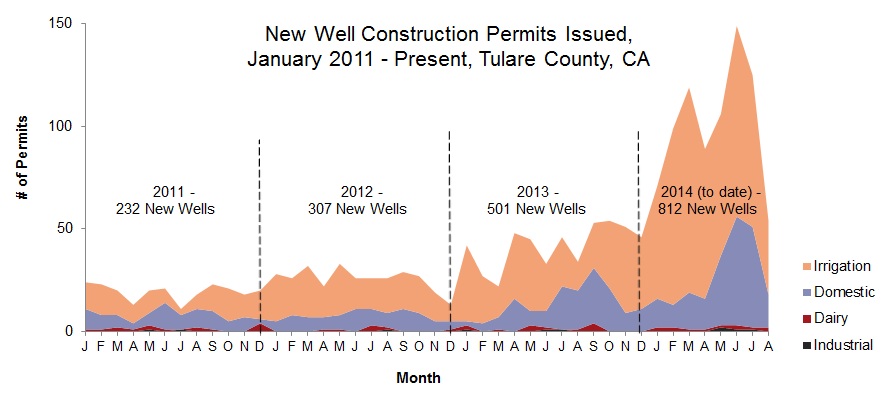
At the same time, the county has not denied a single well drilling application. It has a policy of approving all requests for new wells and does not assess the consequences for other well owners.
“The effect a new well might have on existing wells is considered only in the context of construction standards and setback distances being met,” Ken Bowers, Tulare County environmental health supervisor, told Circle of Blue. “Rights to water are not a consideration and are outside our scope of authority.”
In this battle of straws, the shallow domestic wells are on the short end.
Few Places to Turn to
Like a boulder tumbling downhill, the pace of well failures in Tulare County has accelerated during the dry summer.
“It increased pretty sharply in the last few months,” said Lockman, the emergency services manager. “We’re getting several calls per day now.”
Lockman has a sympathetic ear but can usually offer very little aid for private well owners. Assistance programs are limited, he said. There are few of them, mostly from the U.S. Department of Agriculture (USDA), and those that do exist have strict income requirements.
“The working poor may qualify, and they may not,” he said. “The irony is that those who qualify then have to qualify for a loan, which is hard to do when you’re not making money.”
–Paul Boyer
Self-Help Enterprises
The money that does come in is quickly gobbled up.
“For loans to private well owners, we have way more demand than funds,” said Paul Boyer of Self-Help Enterprises, a community development nonprofit based in Visalia that is administering loans for new domestic wells. The organization just received $US 100,000 from the USDA to provide loans with 1 percent interest, a pool of money that will help nine families.
“It’s helpful, but it’s still a drop in the bucket,” Boyer told Circle of Blue. Depending on the depth and location, drilling a new well costs between $US 16,000 and $US 25,000, as much as some families earn in a year.
The story is different for public water systems that are struggling. Helping these systems, which serve entire communities, is what state and federal aid was set up for, Lockman said. In June, the USDA offered $US 9.7 million to public water systems in California with polluted water or no water. In January, the state began tracking public water systems at risk of running dry, and has channeled money to those most in need.
Seville is a prime example of the difference between public systems and individual wells. Ever since the United Nations’ top water rights expert visited in 2011 and issued a rebuke, the small town in northern Tulare County has been the poster child for Californians with insecure access to good quality drinking water.
Plagued by water pressure so low earlier this summer that faucets were often dry, Seville’s system received a $US 250,000 state grant in August for a new well and a storage tank, both of which should be operating by mid-September, according to county officials.
“The state is very attuned and attentive to the needs of public water systems,” Lockman said. “It’s relatively easy to get money for them. But private wells are an individual responsibility. The government was not set up for private benefits. That might be changing now because so many private wells have failed that it’s starting to be a public health crisis.”
Because the unprecedented number of well failures, few blueprints exist for handling the crisis. County and state officials and community leaders are in unfamiliar territory.
“We’re making the emergency response up as we go,” Ryan Jensen, an organizer with the Community Water Center, a clean drinking water nonprofit in the Central Valley, told Circle of Blue. “I don’t think anyone was well prepared. We’re all working together trying to develop a response. It’s frustrating for the people living day to day with this.”
Residents Pick up the Pieces
A dozen water bottles heating in the midday sun ring the paved driveway outside the Seville home of Maria Venegas. In the shade, Maria gives grandson Julian a bath in a plastic tub.
Maria said the lack of running water is not so bad for her because she remembers living the same way in Mexico before she moved to the United States at age 10.
“But it’s getting to be too much,” she told Circle of Blue. A few of her neighbors have already voted with their feet. Maria points out three houses on her tree-lined block that were recently abandoned by renters.
Thanks to the state grant, Seville will soon have its water system fixed. But many individual well owners elsewhere are not so fortunate. For them, gathering and transporting water is now a daily chore.
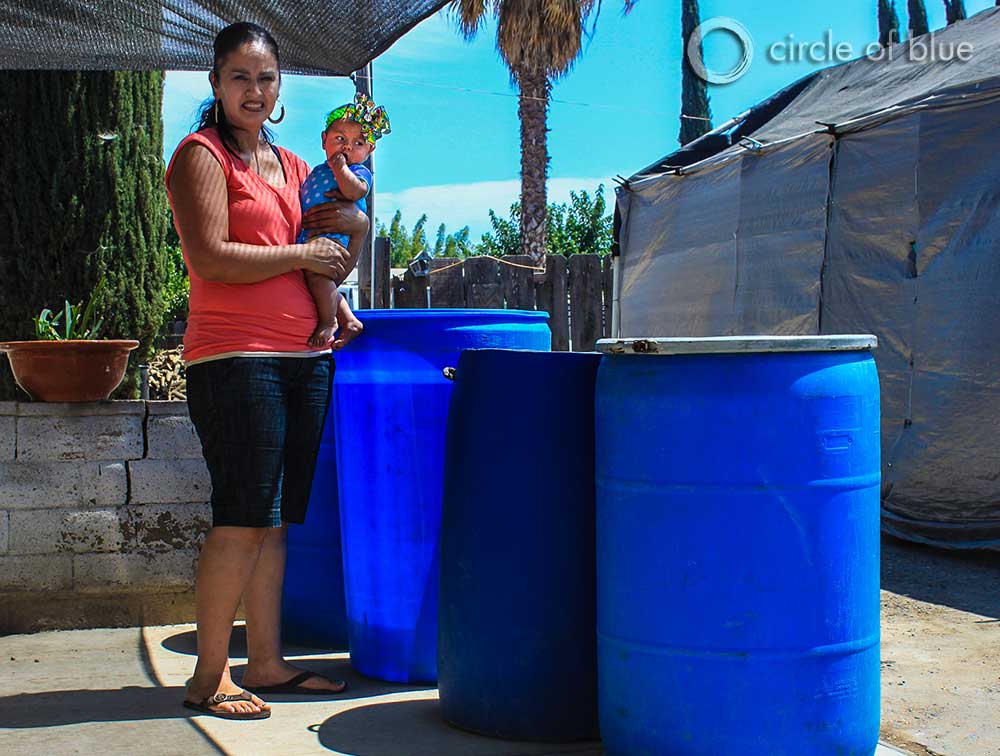
Driving to a friend’s house in Yettem or Orosi, five miles away, Jorge Colunga fills two or three 40-gallon drums per day with water for hand-flushing the toilet and scrubbing clothes. A shower, once a relieving daily ritual, is spooned from a bucket.
Though the limited supply is inconvenient, Gladys Colunga worries more about her children developing back problems from carrying water, a heavy substance at eight pounds per gallon. Like many people on domestic wells in this area, her family does not drink the water even when it flows for fear of nitrate contamination, which can cause stomach problems in adults and can be fatal to infants.
The Colungas’ neighbors, Benjamin and Lala Luengas, also have a dry well, but they temporarily solved the transportation problem. Another neighbor, who recently deepened his well, allows them to connect a hose to his system.
Like Maria’s neighbors, Benjamin and Lala have talked about moving, leaving a house they’ve owned for four decades. If they pull up roots, they might move in with a son who lives nearby in Visalia or with a daughter farther away in Bend, Oregon.
When asked if she blames anyone for the dry well, Lala gestured haphazardly in the air, as if the answer is everywhere and nowhere.
“All that water being sucked up,” Lala said, referring to the farms, which begin just outside the front door. “They’re sucking up the water we need. But what can we do? We can’t tell them to stop. It’s their property.”
Stop signs, however, are on the horizon. State lawmakers will vote this week on a set of new rules for reining in groundwater use. Management plans will be required for the first time for the basins where groundwater is most important and most at risk.
But the effects of the new rules will not be felt for some time. The legislation gives groundwater basins five years to develop a plan and two decades to meet its goals.
Everything – the emergency aid, the legal debates – is moving too slowly for the Colungas.
“Help is not coming soon enough,” Gladys said, as she held Kylie, her six-month-old daughter. “Can’t they get something moving quicker? This is an emergency situation. We’re the lost world here.”
“Sometimes I just want to cry, cry because of my kids,” she added. “If it were just me and my husband, we could deal with it. But the kids are everything.”
Brett writes about agriculture, energy, infrastructure, and the politics and economics of water in the United States. He also writes the Federal Water Tap, Circle of Blue’s weekly digest of U.S. government water news. He is the winner of two Society of Environmental Journalists reporting awards, one of the top honors in American environmental journalism: first place for explanatory reporting for a series on septic system pollution in the United States(2016) and third place for beat reporting in a small market (2014). He received the Sierra Club’s Distinguished Service Award in 2018. Brett lives in Seattle, where he hikes the mountains and bakes pies. Contact Brett Walton



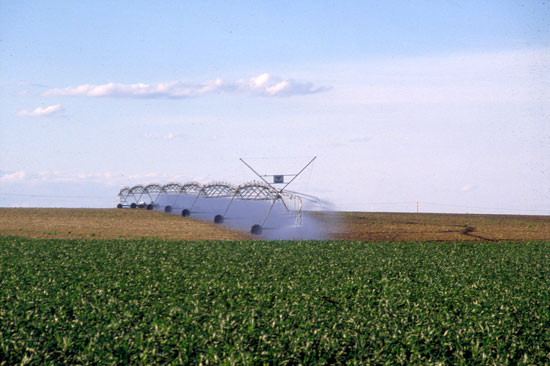
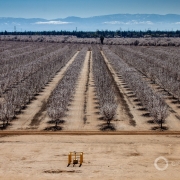




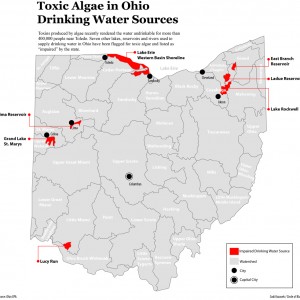

Great post on the importance of making data driven decisions!
CA’s poor are absorbing the consequences of CA’s decisions to drill for wells (and thirsty hydro-fracking rigs)
I’m curious to see what tools their engineers and analysts are using to look at the data that exists to optimize for the water they _do_ have.
Thanks for a great post,
Chris & the DecisionVis Team
I was reading about Tulare County today, and wondered if you were current with this PIVOTAL story of California water management. Thankfully, you are well ahead of the curve, and served us an excellent piece of journalism. I saw that the CA governor was welcoming immigrants to CA,
http://www.latimes.com/local/political/la-me-pc-mexico-president-visit-california-20140825-story.html
and wondered if he understood what was happening in his state. It’s bizarre to say the least.
Again: a truly valuable piece of journalism. Brett and Circle of Blue have done an excellent job of developing the various technical and human layers of the California water crisis, imparting a truly comprehensive description of what is occurring, how, and to whom – and this piece really peels away at the various pressures that are “choking” the system to reveal the bigger picture. I especially admire your dedication to reaching the most marginalised and issue-affected groups – like Maria and her grandson. The line that shocked me the most was, ” For them, gathering and transporting water is now a daily chore.” Are we seriously talking about California?! Shocking. Thank you for telling stories that matter.
Clean out the lakes and sell the top soil for $ for future droughts.
water is being consumed in large amounts by cites that receive no water at all, wells are not deep enough anymore causing the drought to be worse than ever. affecting the poor and people in rural areas